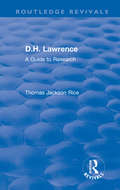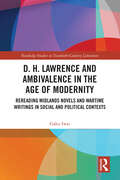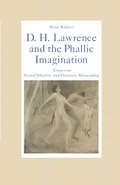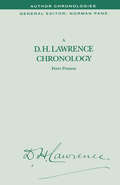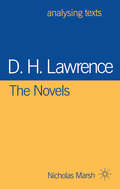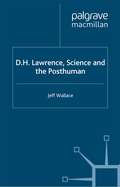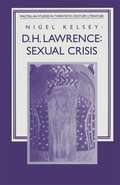- Table View
- List View
D.H. Lawrence: A Guide to Research (Routledge Revivals)
by Thomas Jackson RiceOriginally published in 1983, D.H. Lawrence is an annotated bibliographic collection of works by and about D.H. Lawrence. Consisting of three parts, the primary bibliography contains separate bibliographies of Lawrence’s major publications, of collection editions of his works, of his letters, and of concordances to his writings. The secondary bibliography contains bibliographies of biographical and critical publications concerning Lawrence, generally or his individual works. Appendixes and Indexes include an extensive checklist of major foreign-language publications concerning Lawrence and a useful topical and thematic subject index for the guide.
D.H. Lawrence: A Literary Life (Literary Lives)
by John WorthenLawrence's career as a professional writer is a remarkable story. The son of a coal-miner, he made a moderately successful start to his professional life in 1912; but the banning of his novel The Rainbow in 1915 effectively destroyed his capacity to earn his living by his writing during the War. Even after the War, he wrote an enormous amount in many genres not simply because he was a creative genius, but because his books generally sold so poorly; only Lady Chatterley's Lover ever earned him very much. This study not only describes his day-to-day achievement as a professional writer, but also the problems which influenced his writing.
D. H. Lawrence and Ambivalence in the Age of Modernity: Rereading Midlands Novels and Wartime Writings in Social and Political Contexts (Routledge Studies in Twentieth-Century Literature)
by Gaku IwaiD. H. Lawrence is renowned for his scathing criticism of the ruling class, industrialisation of the country and wartime patriotism. However, his texts bear the imprint of contemporary dominant ideologies and discourses of the period. Comparing Lawrence’s texts to various major and minor contemporary novels, journal articles, political pamphlets and history books, this book aims to demonstrate that Lawrence’s texts are ambivalent: his texts harbour the dynamism of conflicting power struggles between the subversive and the reactionary. For example, in some apparently apolitical texts such as The White Peacock and Movements in European History, reactionary ideologies and wartime propaganda are embedded. Some texts like Lady Chatterley’s Lover are intended to be a radical critique of the period wherein it was composed, but they also bear discernible traces of the contemporary frame of reference that they intend to subvert. Focusing on Lawrence’s stories and novels set in the mining countryside and the works composed under the impact of the First World War, this book establishes that Lawrence’s texts in fact consist of multiple layers that are often in conflict with each other, serving as a testimony to the age of modernity.
D. H. Lawrence and Ambivalence in the Age of Modernity: Rereading Midlands Novels and Wartime Writings in Social and Political Contexts (Routledge Studies in Twentieth-Century Literature)
by Gaku IwaiD. H. Lawrence is renowned for his scathing criticism of the ruling class, industrialisation of the country and wartime patriotism. However, his texts bear the imprint of contemporary dominant ideologies and discourses of the period. Comparing Lawrence’s texts to various major and minor contemporary novels, journal articles, political pamphlets and history books, this book aims to demonstrate that Lawrence’s texts are ambivalent: his texts harbour the dynamism of conflicting power struggles between the subversive and the reactionary. For example, in some apparently apolitical texts such as The White Peacock and Movements in European History, reactionary ideologies and wartime propaganda are embedded. Some texts like Lady Chatterley’s Lover are intended to be a radical critique of the period wherein it was composed, but they also bear discernible traces of the contemporary frame of reference that they intend to subvert. Focusing on Lawrence’s stories and novels set in the mining countryside and the works composed under the impact of the First World War, this book establishes that Lawrence’s texts in fact consist of multiple layers that are often in conflict with each other, serving as a testimony to the age of modernity.
D. H. Lawrence and Feminism (Routledge Revivals)
by Hilary SimpsonFirst published in 1982, D. H. Lawrence and Feminism discusses Lawrence’s work by examining it in relation to aspects of women’s history and the development of feminism. Two different modes of pre-war feminism which provide important themes in Lawrence’s early writings are examined in the opening chapters. The central chapters deal with the war, both as a catalyst for major changes in the position of women and as a point of no return in the development of Lawrence’s work. A final chapter looks at the way in which Lawrence used women as collaborator, and their writing as source material. This book will be of interest to students of literature, women’s studies and history.
D. H. Lawrence and Feminism (Routledge Revivals)
by Hilary SimpsonFirst published in 1982, D. H. Lawrence and Feminism discusses Lawrence’s work by examining it in relation to aspects of women’s history and the development of feminism. Two different modes of pre-war feminism which provide important themes in Lawrence’s early writings are examined in the opening chapters. The central chapters deal with the war, both as a catalyst for major changes in the position of women and as a point of no return in the development of Lawrence’s work. A final chapter looks at the way in which Lawrence used women as collaborator, and their writing as source material. This book will be of interest to students of literature, women’s studies and history.
D. H. Lawrence and Narrative Viewpoint (Advances in Stylistics)
by Violeta SotirovaThis book is a stylistic study of D. H. Lawrence's presentation of narrative viewpoint. The focus is mainly on Lawrence's third novel, Sons and Lovers, occupying a crucial position in his oeuvre and judged by critics to be his first mature piece.While sharing many features typical of nineteenth-century novels, it marks the emergence of a new technique of writing consciousness that functioned as a precursor to the modernist practice of dialogic shifts across viewpoints. Through a detailed linguistic analysis, Sotirova shows that different characters' viewpoints are not simply juxtaposed in the narrative, but linked in a way that creates dialogic resonances between them. The dialogic linking is achieved through the use of devices that have parallel functions in conversational discourse - referring expressions, sentence-initial correctives and repetition. The book uses stylistics to resolve current controversies in narratology and Lawrence criticism.In approaching the study of narrative viewpoint from the angle of discourse, Sotirova arrives at cutting-edge insights into Lawrence's work. This book will be required reading for stylisticians, narratologists, literary linguists and literary studies scholars.
D. H. Lawrence and the Authoritarian Personality
by Barbara MenschA documentation of D.H.Lawrence's insight into and portrayal of the destruction of self and society inherent in authoritarianism. The author begins her study with detailed definitions of the operative terms upon which the book based - fascism, authoritarianism and totalitarianism.
D. H. Lawrence and the Phallic Imagination: Essays on Sexual Identity and Feminist Misreading (pdf)
by Peter BalbertA D.H. Lawrence Chronology (Author Chronologies Series)
by P. Preston'Peter Preston has written and made thoroughly accessible to its readers a book which no-one working on Lawrence can now afford to have far from their work-table. How ever did we live without it? It has become, at a stroke, indispensable.' - John Worthen, D H Lawrence Society's Newsletter 'It creates a most absorbing chronological sequence out of materials brought together from an extremely wide variety of sources, in a very effective and professional way.' - Nicola Ceramella This volume traces the progress of Lawrence's life from its beginnings in the English Midlands through his world-wide travelling until his death in 1930. Details of the composition of his works in many forms and of the controversies that often followed their publication are included. Drawing on information from recent scholarly editions of his letters and works, it also offers details of his wide reading, and his relationships with figures as varied as E.M. Forster, Bertrand Russell, Katherine Mansfield, Lady Ottoline Morell and Aldous Huxley.
D. H. Lawrence, Ecofeminism and Nature (Routledge Studies in World Literatures and the Environment)
by Terry GiffordThis is the first ecocritical book on the works of D. H. Lawrence and also the first to consider the links between nature and gender in the poetry and the novels. In his search for a balanced relationship between male and female characters, what role does nature play in the challenges Lawrence offers his readers? How far are the anxieties of his characters in negotiating relationships that might threaten their sense of self derived from the same source as their anxieties about engaging with the Other in nature? Indeed, might Lawrence’s metaphors drawn from nature actually be the causes of human actions in The Rainbow, for example? The originality of Lawrence’s poetic and narrative strategies for challenging social attitudes towards both nature and gender can be revealed by new approaches offered by ecocritical theory and ecofeminist readings of his books. This book explores ecocritical notions to frame its ecofeminist readings, from the difference between the ‘Other’ and ‘otherness’ in The White Peacock and Lady Chatterley’s Lover, ‘anotherness’ in the poetry of Birds, Beasts and Flowers, psychogeography in Sea and Sardinia, emergent ecofeminism in Sons and Lovers, land and gender in The Boy in the Bush, gender dialogics in Kangaroo, human animality in Women in Love, trees as tests in Aaron’s Rod, to ‘radical animism’ in The Plumed Serpent. Finally, three late tales provide a reassessment of ecofeminist insights into Lawrence’s work for readers in the present context of the Anthropocene.
D. H. Lawrence, Ecofeminism and Nature (Routledge Studies in World Literatures and the Environment)
by Terry GiffordThis is the first ecocritical book on the works of D. H. Lawrence and also the first to consider the links between nature and gender in the poetry and the novels. In his search for a balanced relationship between male and female characters, what role does nature play in the challenges Lawrence offers his readers? How far are the anxieties of his characters in negotiating relationships that might threaten their sense of self derived from the same source as their anxieties about engaging with the Other in nature? Indeed, might Lawrence’s metaphors drawn from nature actually be the causes of human actions in The Rainbow, for example? The originality of Lawrence’s poetic and narrative strategies for challenging social attitudes towards both nature and gender can be revealed by new approaches offered by ecocritical theory and ecofeminist readings of his books. This book explores ecocritical notions to frame its ecofeminist readings, from the difference between the ‘Other’ and ‘otherness’ in The White Peacock and Lady Chatterley’s Lover, ‘anotherness’ in the poetry of Birds, Beasts and Flowers, psychogeography in Sea and Sardinia, emergent ecofeminism in Sons and Lovers, land and gender in The Boy in the Bush, gender dialogics in Kangaroo, human animality in Women in Love, trees as tests in Aaron’s Rod, to ‘radical animism’ in The Plumed Serpent. Finally, three late tales provide a reassessment of ecofeminist insights into Lawrence’s work for readers in the present context of the Anthropocene.
D. H. Lawrence in Italy and England
by George Donaldson Mara KalninsThe critical essays in this volume, by leading authorities on D. H. Lawrence, focus on the importance of Italy and England in Lawrence's work and life. They span the years of his creative maturity from 1915 - which witnessed the important visit to Cambridge, the revisions to Twilight in Italy and the banning of The Rainbow - to 1926, the year in which he began research for the pieces that became Etruscan Places .
D. H. Lawrence in the Modern World
by Peter Hoare Peter Preston60 years after Lawrence's death, the nature of his achievement is still being debated. His vision has aroused passionate interest in many countries beyond his own. As a writer in the 20th century and as one with international standing, this book presents Lawrence "in the modern world".
D.H. Lawrence, Music and Modernism (Palgrave Studies in Music and Literature)
by Susan ReidThis first book-length study of D. H. Lawrence’s lifelong engagement with music surveys his extensive musical interests and how these permeate his writing, while also situating Lawrence within a growing body of work on music and modernism. A twin focus considers the music that shaped Lawrence’s novels and poetry, as well as contemporary developments in music that parallel his quest for new forms of expression. Comparisons are made with the music of Debussy, Schoenberg, Stravinsky, Wagner, and British composers, including Bax, Holst and Vaughan Williams, and with the musical writings of Forster, Hardy, Hueffer (Ford), Nietzsche and Pound. Above all, by exploring Lawrence and music in historical context, this study aims to open up new areas for study and a place for Lawrence within the field of music and modernism.
D. H. Lawrence: New Studies (pdf) (Studies in 20th Century Literature)
by Christopher Heywood Paolo BartoloniD.H. Lawrence: The Novels (Analysing Texts)
by Nicholas MarshThis volume focuses on three widely-studied novels: Sons and Lovers, The Rainbow and Women in Love. Chapters on narrative texture, impulse and emotion in Lawrence's characters, the quest for a male-female relationship, class and society, and imagery, symbols and structures, use practical analysis to build and refine our insight into the novels as well as equipping the readers with techniques and approaches which enable them to continue studying Lawrence independently. Suggestions for further reading, fully explained examples of analysis and suggestions for further work, make this volume both accessible and a bridge to further study.
D.H. Lawrence, Science and the Posthuman
by J. WallaceWhy was D.H. Lawrence preoccupied with the enigma of the human as thinking matter? This first sustained study of Lawrence and science shows how 'posthuman' conceptions of a material kinship between humans, animals and machines can transform our understanding of Lawrence's work and of its complex relationship with scientific epistemologies. Through detailed readings of evolutionary philosophy, and of the 'new Bergsonism' of Deleuze and others, Wallace provides a radical reappraisal of Lawrence in terms of an 'antihumanist (or posthumanist) humanism' (Hardt and Negri).
D. H. Lawrence: Sexual Crisis (pdf) (Studies in 20th Century Literature)
by NIgel Kelsey Helen CooperD. H. Lawrence, Technology, and Modernity
by Indrek MännisteWhile the dehumanizing effects of technology, modernity, and industrialization have been widely recognized in D. H. Lawrence's works, no book-length study has been dedicated to this topic. This collection of newly commissioned essays by a cast of international scholars fills a genuine void and investigates Lawrence's peculiar relationship with modern technology and modernity in its many and varied aspects. Addressing themes such as pastoral vs. industrial, mining, war, robots, ecocriticism, technologies of the self, film, poetic devices of technology, entertainment, and many others, these essays help to reevaluate Lawrence's complicated standing within the modernist literary tradition and reveal the true theoretical wealth of a writer whose whole life and work, according to T.S. Eliot, "was an assertion of what the modern world has lost."
D. H. Lawrence, Technology, and Modernity
by Indrek MännisteWhile the dehumanizing effects of technology, modernity, and industrialization have been widely recognized in D. H. Lawrence's works, no book-length study has been dedicated to this topic. This collection of newly commissioned essays by a cast of international scholars fills a genuine void and investigates Lawrence's peculiar relationship with modern technology and modernity in its many and varied aspects. Addressing themes such as pastoral vs. industrial, mining, war, robots, ecocriticism, technologies of the self, film, poetic devices of technology, entertainment, and many others, these essays help to reevaluate Lawrence's complicated standing within the modernist literary tradition and reveal the true theoretical wealth of a writer whose whole life and work, according to T.S. Eliot, "was an assertion of what the modern world has lost."
D. H. Lawrence, Transport and Cultural Transition: 'A Great Sense of Journeying'
by Andrew F. HumphriesThis book discusses D. H. Lawrence’s interest in, and engagement with, transport as a literal and metaphorical focal point for his ontological concerns. Focusing on five key novels, this book explores issues of mobility, modernity and gender. First exploring how mechanized transportation reflects industry and patriarchy in Sons and Lovers, the book then considers issues of female mobility in The Rainbow, the signifying of war transport in Women in Love, revolution and the meeting of primitive and modern in The Plumed Serpent, and the reflection of dystopian post-war concerns in Lady Chatterley’s Lover. Appealing to Lawrence, modernist, and mobilities researchers, this book is also of interest to readers interested in early twentieth century society, the First World War and transport history.
D. H. Lawrence, Transport and Cultural Transition: 'A Great Sense of Journeying'
by Andrew F. HumphriesThis book discusses D. H. Lawrence’s interest in, and engagement with, transport as a literal and metaphorical focal point for his ontological concerns. Focusing on five key novels, this book explores issues of mobility, modernity and gender. First exploring how mechanized transportation reflects industry and patriarchy in Sons and Lovers, the book then considers issues of female mobility in The Rainbow, the signifying of war transport in Women in Love, revolution and the meeting of primitive and modern in The Plumed Serpent, and the reflection of dystopian post-war concerns in Lady Chatterley’s Lover. Appealing to Lawrence, modernist, and mobilities researchers, this book is also of interest to readers interested in early twentieth century society, the First World War and transport history.
